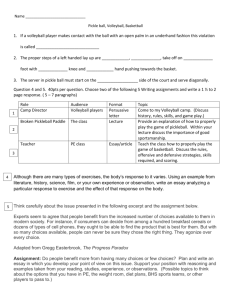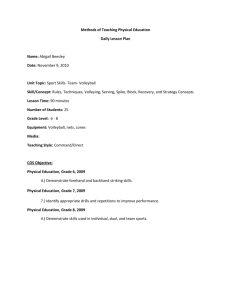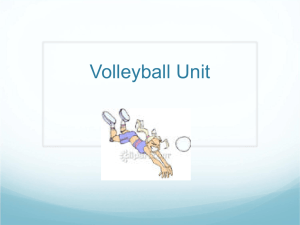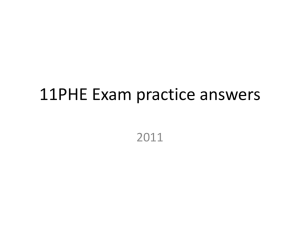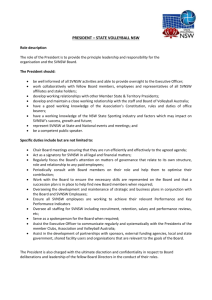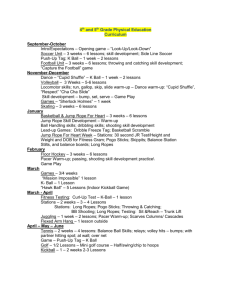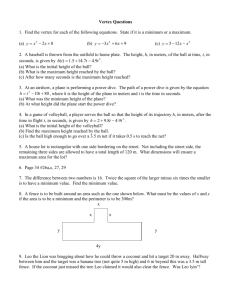Volleyball grade 6 and 7 Lesson Plan
advertisement
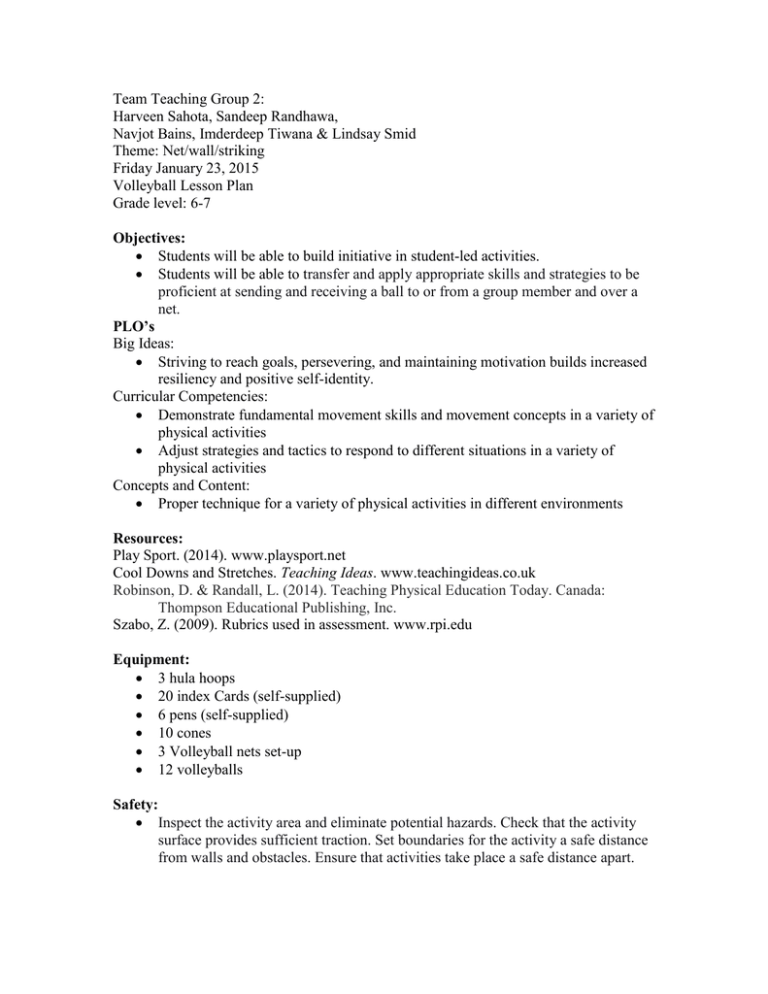
Team Teaching Group 2: Harveen Sahota, Sandeep Randhawa, Navjot Bains, Imderdeep Tiwana & Lindsay Smid Theme: Net/wall/striking Friday January 23, 2015 Volleyball Lesson Plan Grade level: 6-7 Objectives: Students will be able to build initiative in student-led activities. Students will be able to transfer and apply appropriate skills and strategies to be proficient at sending and receiving a ball to or from a group member and over a net. PLO’s Big Ideas: Striving to reach goals, persevering, and maintaining motivation builds increased resiliency and positive self-identity. Curricular Competencies: Demonstrate fundamental movement skills and movement concepts in a variety of physical activities Adjust strategies and tactics to respond to different situations in a variety of physical activities Concepts and Content: Proper technique for a variety of physical activities in different environments Resources: Play Sport. (2014). www.playsport.net Cool Downs and Stretches. Teaching Ideas. www.teachingideas.co.uk Robinson, D. & Randall, L. (2014). Teaching Physical Education Today. Canada: Thompson Educational Publishing, Inc. Szabo, Z. (2009). Rubrics used in assessment. www.rpi.edu Equipment: 3 hula hoops 20 index Cards (self-supplied) 6 pens (self-supplied) 10 cones 3 Volleyball nets set-up 12 volleyballs Safety: Inspect the activity area and eliminate potential hazards. Check that the activity surface provides sufficient traction. Set boundaries for the activity a safe distance from walls and obstacles. Ensure that activities take place a safe distance apart. Application of principles of learning: In our warm-up we’ve included jogging to increase heart rate and encourage movement before we begin the circuit. During the circuit the purpose is to target different muscle groups (arms, legs, and core) in order prepare students for the following activity. We’ve also added a component where students provide input into the exercises they will participate in to make it more student-centered and get them thinking about their own role in developing their physical literacy. The volleyball component of this lesson is intended to occur during the beginning of the volleyball unit (the 2 or 3 lesson). It is expected that students have already been introduced to the concepts and basic movements involved in volleyball. By using the game “Twos” we are reinforcing the objective of having 3 hits between your team on each side before returning it over the net. We demonstrate this by breaking down the game into 3-sided half court games with the rule of passing the ball twice before returning the ball to the other team. This applies the Sport Model (TGfU) by breaking down the more complex game of volleyball into a simpler format in order for students to experience, understand and enjoy games before increasing complexity (Robinson and Randall, 2014). In the game “Twos” we emphasize tactical awareness, game play and skill execution. How to Meet Developmental Needs of Children: This lesson is tailored to grade 6/7 students in an elementary school PE setting. Robinson and Randall (2014, p.57) argue that according to Bloom’s Taxonomy of Educational Objectives students that have acquired knowledge, skills and attitudes at lower levels will thus be able to build upon them and be capable of higher order thinking. In order to account for this, and to develop students’ physical literacy we have added a component to the warm-up where students go beyond simply remembering and repeating and take initiative to build knowledge and understanding by generating their own ideas. In addition, we assume a higher level of physical ability as students have progressed throughout elementary school and are now capable of satisfying more complex objectives. Organizational strategies: Use a whistle to get attention of class Have students “huddle in” while giving instructions Number students 1-6, including leaders, for warm-up and volleyball activity o Divide the group of 6 into two groups of 3 Have equipment ready in advance Assessment: (Rubric attached) Running weekly assessment: Rubric from 1-5 below expectations to exceeding expectations. PE Journal: The teacher asks questions to help participants reflect about their participation. Students will write a response to two of the questions in their PE journals. After self-assessment teacher records students’ responses on a scale of 15 from below expectations to exceeding expectations. Examples include: 1. For the activities that were easy for you, how did you adjust to make them challenging? 2. For the activities that were difficult for you, how did you adjust to be able to do them? 3. Some of the movement activities may be new to you. Why is it important to try new things? 4. What does it look and sound like when you are performing at your best when being physically active? 5. How did working with someone else at your station help you do your best? Outline: Warm-up, Volleyball Activities, Cool Down Time Activity Leader 0-3 mins Warm-up: Jog 2 laps Harveen 3-10 mins Warm-up: “Circuit Sandeep, Navjot Circus” 10-12 mins Activity 1:Volleyball skill Imderdeep, Lindsay instruction (bumping and volleying) 12-17 mins Activity 2: Practice Harveen volleyball skills in group of 3 17-27 mins Play “Twos” Lindsay 27-30 mins Cool down: Stretch Navjot Warm-up: 1. Jog 2 laps around the gym at your own pace. The purpose is to get student’s heart rate up and ready to participate in the next activity. 2. Circus Circuit: (adapted from playsport.net, “Circuit Circus”) o Divide participants into groups of 6. o Prior to starting the circuit, participants can help generate active fitness activities to be placed on the station cards. o Set up hula hoops in the center of a square and place cue cards with fitness activities identified on them in the middle of each hoop.. Consider using pictures or illustrations showing how the fitness activity is performed and placing more than one activity on each piece of paper to provide student choice. o Some possible fitness activities include: running on the spot (cardiovascular fitness), push-ups (muscular strength and endurance), stork stand (muscular endurance and balance enhancement). o Each group will send one person to pick a cue card from the hula hoop. They need to complete one activity from each hoop before they are finished. o Check for understanding: Have student who understands the task to model the previous instructions. Adaptations for needs of diverse learners: To maximize the challenge and the fun, participants could identify their own ways to increase or decrease the challenge. To decrease the challenge: Choose movement activities that they already know (e.g., moves from a dance already learned). Reduce the amount of time for each station. To increase the challenge: Track the number of repetitions they were able to complete within the allotted time at each station. Complete a second circuit of the activities and try to beat their previous number of repetitions. Instruction: Volleying and Bumping Model proper technique: Volleying: Slight bend in elbows, make a triangle index fingers and thumbs, curl fingers, look through hands and keep your eye on the ball. Extend your elbows and push out and up. Bumping: Bend your knees, right hand over left hand, thumbs on top. Use your legs, shrug your shoulders and extend legs. Have students repeat bumping/volleying action together. “Twos” Volleyball Activity (Adapted from playsport.net, “Twos”) Activity Set-up: ● Participants divide into groups of six. Within their groups, participants find a group of 3. ● Each group sets up their activity area in the shape of a rectangle marked with 1 pylon in each corner. Divide each side of the net into a front and back court using two pylons per side. ● Participants set up in groups of three on each side of the net and one partner within each zone. Activity Instructions: ● In threes volley the ball over the net and onto their opponents’ side of the court, trying to prevent their opponents from being able to return the ball before it hits the ground. ● Each participant within the threes should hit the ball before it can be hit over the net. Participants should try to stay within their zones. ● A group receives a point if they hit the ball to the other side and the other group is unable to return it, or if both players on the other group have not touched the ball. ● Threes keep track of their points and work together to gather the maximum number of points. Model the previous instructions. Check for understanding: Have student who understands the task to repeat to class. Adaptations for needs of diverse learners: To maximize the challenge and the fun, participants could identify their own ways to increase or decrease the challenge. To decrease the challenge: ● Allow 1 bounce before receiving the ball. ● Catch the ball before sending it back to the other side of the net. To increase the challenge: Add a rule about the number of contacts each player has with the ball before returning it over the net. ● Play the game against a wall. Add serving into the game. Cool Down: (Adapted from teachingideas.com.uk, “Cool Downs and Stretches”) Have students walk around in a circle until the leader calls out “STOP!”. Then the leader will call out a stretch. Hold the stretch and then instruct students to resume walking in a circle. Repeat. o Calf and hip stretch. Take a giant step forward with your left foot. Bend your left knee (but don't push it beyond your foot); keep your right heel on the ground and your right leg straight behind you. Keep your abdominal muscles gently contracted so there's no excess arch in your back. You should feel the stretch in both your right calf and hip. Hold for several deep breaths. Then switch legs and repeat. o Back and hamstring stretch. Stand with your feet together and your knees slightly bent. Lean forward from the waist and let your arms and head hang loosely toward the ground. Don't necessarily try to touch your toes – just let your body hang under its own weight and ease into the stretch with each deep exhale. Slowly stand up (to avoid lightheadedness) and repeat. o Shin and thigh stretch. Grasp your right toes with your right hand, and gently pull your foot up behind you, keeping your right knee pointed toward the ground. Your heel doesn't have to reach your buttocks – just pull to the point of feeling a gentle stretch in the front of the thigh, hip, and shin. Hold for several deep breaths. Then switch legs and repeat. Running weekly assessment: Rubric from 1-5 below expectations to exceeding expectations on skill development (SD) and participation (P). Student Name Date: Jan. 16 SD P Steve M. 5 5 Fay B. 5 3 Navjot B. 4 3 Harveen S. 3 5 Imderdeep T. 4 4 Date: Date: Date: Grading Scale: 1- Not meeting expectations: misunderstanding of majority of concepts or no understanding of concepts and processes 2- Approaching expectations: understands, but lack of demonstration in application of main ideas 3- Meeting expectations: understanding and application of most critical concepts 4- Above average: Student shows complete understanding of the tasks and concepts 5- Exceeding expectations: Student shows complex understanding of tasks and application (Adapted from www.rpi.edu, “Rubrics Used in Assessment”) PE Journal: The teacher asks questions to help participants reflect about their participation. Students will write a response to two of the questions in their PE journals. Consideration will be made for thoughtfulness of response, progression and engagement with course content. After self-assessment teacher records students’ responses on a scale of 1-5 from below expectations to exceeding expectations. Examples include: 1. For the activities that were easy for you, how did you adjust to make them challenging? 2. For the activities that were difficult for you, how did you adjust to be able to do them? 3. Some of the movement activities may be new to you. Why is it important to try new things? 4. What does it look and sound like when you are performing at your best when being physically active? 5. How did working with someone else at your station help you do your best?
